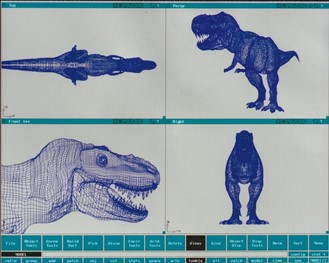Computer-Generated Imagery, abbreviated as CGI, creates still or animated visual content with computer software. CGI is also called 3D imaging or 3D Rendering. CGI usually refers to the 3D computer graphics used to create characters, scenes, and other special effects in movies, television, and games. This technology is also used in advertising, architecture, engineering, virtual reality, and even art. In traditional photography, film or a digital camera captures an image whereas computer-generated images are created in computer software. Three-dimensional (3D) outputs are often connected with CGI. Still, CGI can also create two-dimensional (2D) effects.


CGI is created using different methods:
- Using algorithms can create complex fractal patterns.
- 2D pixel-based image editors can produce vector shapes.
- 3D graphics software can generate everything from simple primitive shapes to complex forms created from flat triangles and quadrangles.
3D software can simulate the way light reacts to a surface and creates particle effects.
The CGI trailer for Game of Thrones Winter is Coming

CGI starts to get exciting when it is layered into digital film footage using compositing. This technique is growing more familiar to people, often referred to as a “Green screen.”
The History of CGI
The history of CGI goes back to the 1950s when mechanical computers were used to create patterns onto animation cels which were then included in a feature films. The first film which used CGI was Alfred Hitchcock’s Vertigo (1958).
Vertigo (1958) – First computer animation ever! (HD)

Alfred Hitchcock might have started early with some 2D trickery. Still, it wasn’t until 1972 when Edwin Catmull and Fred Parke made a computer-animated short film named “A Computer Animated Hand” that introduced 3D computer graphics to everyone. This was achieved when Edwin drew 350 triangles and polygons in ink on his hand and then digitized and carefully animated the data in a 3D animation program that Catmull wrote.
“A computer animated hand” – 1972
A few years later, CGI took another step forward with the help of Hollywood. In 1973 Westworld displayed its capability with the first 2D CGI scene showing “Gunslinger” vision – an idea of how robots could see. The movie was very successful that it inspired a sequel.
Westworld (1973) – First blend of CGI and live action in a feature film (HD)
The boundaries of CGI were pushed to the future world even further when it rendered a 3D head with the same techniques as Edwin Catmull had outlined. The surprise is that the studio executives used the original hand animation created by Edwin and incorporated it into the film. The Oscars quickly recognized this excellent work about a decade later with a Scientific & Engineering Academy Award.
1976, Futureworld – World’s first 3D animation in a movie
Soon after robot cowboys blew everyone away, Industrial Light & Magic created an iconic piece of cinema history that showed CGI’s potential. The Trench Run Briefing in Star Wars: A New Hope showed a wireframe rendering of the Death Star created to help give the Rebel Alliance some last-minute training. Directed by George Lucas, the film and its incredible imagery would ultimately become indirectly responsible for ushering in the CGI era.
Star Wars: A New Hope — Red Leader Fails the Trench Run ᴴᴰ
It took many years for computers to fully harness CGI’s power and allow directors to bring their visions to life. Finally, however, by the end of the ’70s, computer-generated imagery started rising in a few science fiction movies like The Black Hole (more wireframe goodies) and Alien (another wireframe).
Around the 1980s, Industrial Light & Magic fell into second gear. It truly changed cinema for good with the release of Tron in 1982. Due to the advanced complexity of the film, its first-time Producer and Director, Walt Disney, almost passed up on the chance. The movie didn’t break the box office records, but it did win an Academy Award fourteen years later.
CGI continued to push the boundaries of computer power in the 1980s – For example, The Last Starfighter (1984), The Abyss (1989), and more such films, jump in to try their hand at this mesmerizing mix of technology and art.
In the 1990s, computers allowed CGI masters to start going big with their ideas and newly found techniques. During this decade, many groundbreaking films were released, like Terminator II, Judgment Day (1991), Toy Story (1995), Star Wars Special Editions, and The Matrix (1999).
ILM, Stan Winston Studios, and Phil Tippett led many of these movies, who dropped arguably the best CGI – Jurassic Park (1993). The bar was set so high, and with this, many CGI artists strongly believe Jurassic Park has the best visual effects to date. What actually changed at this point was how they used a mix of real characters, animatronics, and CGI bringing dinosaurs to life alongside the artists, which has never been successfully done before.




Images Source: The Rookies
In 1995, a movie was wholly directed with CGI for the first time, which gave birth to the most celebrated “Toy Story.” Later we have Pixar producing classic CGI movies “Monsters Inc.” and “Finding Nemo.” The realistic characters of these movies- Woody, Buzz, Sullivan, Mike, Nemo, Gill, and Bloat circle and keep the audiences entertained throughout.
How Pixar’s Animation Has Evolved Over 24 Years, From ‘Toy Story’ To ‘Toy Story 4’ | Movies Insider
Beyond 2000, CGI accelerated at a never-before rate. The need for more computer power, more reliable software, and new ideas helped many CGI films. One such movie from the canon is the “Lord of the Rings.” Gollum became the first CGI character to interact with real actors. Filmmakers utilized motion capture technology to make Gollum realistic and lively. This suggests that a live actor played Gollum’s role, which matched the CGI Gollum to his movements.
CGI plays an integral part in all feature films nowadays. There is simply no pixel that is untouched these days by CGI. For example, in Jurassic Park again, no more than 63 visual effects shots were crafted for this film. Also, The Avengers has over 2,200 visual effects shots using CGI. Even the widely praised Guardians of the Galaxy relied on CGI for 2,750 of its shots. In other words, 90 percent of this movie feature CGI in some capacity.
Jurassic Park’s T-Rex Paddock Attack – Art of the Scene
15 Avengers Endgame Scenes Before And After CGI
Go Behind the Scenes of Guardians of the Galaxy Vol. 2 (2017)
What are CGI characteristics?
- 2D computer-generated imagery, like text, objects, backgrounds, and environments.
- 3D objects, figures, spaces, and environments.
- In suitable cases, composite imagery and video trick the eye into believing in the illusion presented.
- In bad cases, fake figures, renderings, objects, and environments look artificial and/or stand out regarding everything else.
Applications of CGI
CGI is applied in almost every possible place as most people believe it can attain one’s attention. But some of the prime applications where CGI is playing a prominent role are:
- Movies
- Real Estate
- Visual Art
- Video Games
- Engineering
- Marketing
- Advertising
- Television Shows & more
Key Roles and Departments Involved in CGI
The creation of CGI involves a very long process that is challenging and very technical. Teams are large and diverse, involving people ranging from hardcore coders to illustrators and non-artists. Everyone plays a crucial role in designing the best visual effects for their client. Some of the most creative and technical functions involved in the creation of CGI are:
- Art Department
The Art Department translates a director’s vision and a script into visuals shared with the whole team to understand the creative and technical challenges. In addition, these concept artists and illustrators design everything from storyboards to photorealistic artworks that show the finished shot.
Turning our Most Famous Videos Into Trippy CG Art!
- Pre-viz
Pre-visualization Artists create the first 3D representation of the final visual effects shot. After that, they usually make low-quality versions of the action sequences using artwork and basic 3D models. The Director then plans out the camera placement and other creative/technical requirements.
Pre-Visualization for Film with Jason Michael Hall
- Asset Department
Virtual assets are needed in visual effects to match real-world objects or build new objects that don’t exist or are too expensive to create in the real world. These are designed mainly by modeling artists, texture painters, shader developers, and riggers.
- Research and Development
RnD is a technical department. It builds new software and tools to accomplish tasks that are impossible to do or are too time-consuming for artists to complete over and over again manually. Therefore, the role requires a solid background in computer science and a passion for problem-solving.
- Animation Team
In the film, anything that moves needs to be animated. It doesn’t matter if it’s a small property like a chair, a hero character, or a creature. An animator will probably be behind the controls if there’s a movement and a performance.
10 Movies That Changed CGI This Decade | Movies Insider
- Matchmove
Matchmove is also known as motion tracking. Without it, there would be no chance to incorporate 3D data into live-action footage. However, to make digital assets appear genuine, you need a virtual camera that moves like the camera in the live-action footage. This is where match-move artists come into action. It’s their job to use the live-action video footage and create a virtual camera for all departments to work with.
- FX Simulation
An FX Artist will design and create FX animation, procedural simulation, dynamic simulation, and particle and fluid systems. They are responsible for recreating the behavior of real-world elements such as fire, water, cloth, explosions, hair, and many more that most people don’t even realize. FX artist is a highly technical yet creative role.
Avengers: Endgame VFX | Breakdown – FX Simulations | Weta Digital
The lighting artist is the one who applies all lighting effects to the digital scene. The artist considers the light sources of the live-action plate and uses virtual lighting to mimic the existing illumination within the environment. Here, the goal is to ensure that the VFX and live-action elements blend seamlessly, as both exist in the same domain.
- Matte paint
A matte painting is an image that employs digital or traditional painting techniques to represent a scene that filmmakers would not deliver in real life. This might be because the landscape doesn’t exist in the real world; it’s not financially practical to travel to a location or extend the set outside its filmed parameters.
MOVIES BEFORE AND AFTER SPECIAL EFFECTS
Rotoscoping is used to build a matte or mask for an object to be extracted out of place on a background that is different, masked out so colors can be changed, or any other set of reasons. The rotoscoping artist will usually trace an object using tools to create a new alpha channel for a specific portion of an image sequence or video.
- Compositing
Compositing is the act of layering all the elements in a shot: live-action, mattes, 3D lighting, multiple CG passes, animation, and particle effects. Then, it blends them all perfectly to create the photorealistic final shot. Working during the production process, you’ll need to work closely with other VFX departments to creatively and technically solve problems along the way.
- Production
There are also several roles for people who prefer managing teams, budgets, and schedules. For example, the top production role at a studio is the VFX Producer. He:
- Collaborates with the VFX supervisor to manage the whole process
- Defines the resources required
- Hires artists and crew
- Manages budgets
- Makes sure the project is delivered on schedule
Other typical roles include:
- Production Manager
- Production Coordinator
They support the Producer by liaising with artists, flagging issues, generally tracking the progress, and ensuring everything stays on track from a scheduling perspective.
Where Can CGI go Wrong?
The art of computer graphics is highly technical and requires hundreds, often thousands of highly skilled artists. The problem is that as CGI advances in movies, so do the audience. The audiences become critics and can start picking out the flaws made by the CGI team at any stage. The good news is that studios have realized that story is king, not the CGI. Computer graphics should be a tool to tell a story, and they should never be the reason for creating a film.











